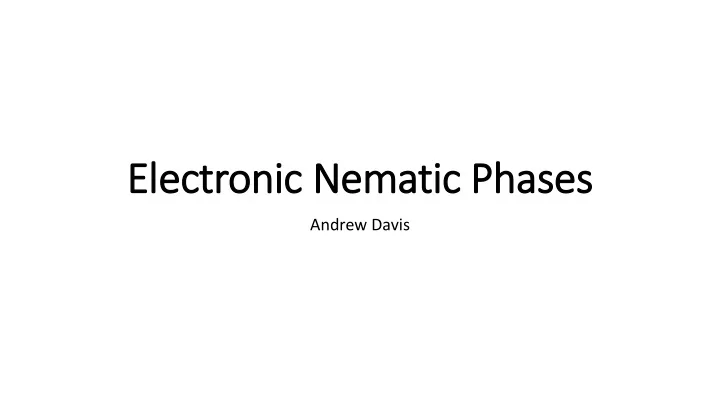

Electronic Nematic Phases Andrew Davis
Preliminaries – Fermi Liquid Theory • Begin with free Fermi gas – elementary excitations are particles/holes • Adiabatically turn on interactions → quasiparticles • 1-to-1 correspondence between non-interacting and interacting states • Quasiparticles have same quantum numbers • At low T, we have a dilute gas of quasiparticles • State characterized by 𝜀𝑜 𝑞
Preliminaries – Fermi Liquid Theory Effect of interactions • Energy functional for a state 𝜀𝑜 𝑞 : 𝜁 𝑞 𝜀𝑜 𝑞 + 1 𝐹 = 𝐹 0 + 2 𝑔 𝑞𝜏𝑞 ′ 𝜏 ′ 𝜀𝑜 𝑞𝜏 𝜀𝑜 𝑞 ′ 𝜏 ′ + ⋯ 𝑞𝜏𝑞 ′ 𝜏 ′ 𝑞𝜏 • Expand interaction in Legendre polynomials: ∞ 𝑚 ( 𝑙 ∙ 𝑙 ′ )𝑔 𝑔 𝑞 𝐺 𝑙′ = 𝑄 𝑙,𝑞 𝐺 𝑚 𝑚=0 • Feedback mechanism and distortion of Fermi surface • Nature of feedback depends on the 𝑔 𝑚
Preliminaries – Pomeranchuk instabilities • Feedback may be positive or negative • Fermi pressure stabilizes the FS • But if any 𝑔 𝑚 < −(2𝑚 + 1) , we get “runaway” feedback • FS unstable to this deformation • Fermi Liquid Theory breaks down – new phase
Nematic phases defined Classical Electronic • Rod-like molecules which break • The electron fluid breaks the sym. of the underlying Hamiltonian which orientational symmetry interchanges two axes – despite no • Order parameter is a director anisotropy in lattice! • Resulting anisotropy is in k -space • Observed through transport anisotropies, etc. 𝜍 𝑦𝑦 −𝜍 𝑧𝑧 • Many choices of OP – e.g. 𝜍 𝑦𝑦 +𝜍 𝑧𝑧 • Examples: C 4 → C 2 , C ∞ → C 2 Fradkin et al. 2010, Nematic Fermi Fluids in Condensed Matter Physics
Two views of nematicity “Strong coupling” view: a smectic crystal melts “Weak coupling” view – a PI destroys a Fermi liquid l = 2 channel (quadrupole) Broken orientational sym. Broken orientational sym. Broken translational sym. Restored translational sym.
An Example – Sr 3 Ru 2 O 7 Borzi et al. 2007, Formation of a Nematic Fluid at High Fields in Sr 3 Ru 2 O 7
Model of an anisotropic system with a dPI Interaction which n.n. and n.n.n. Explicit xy drives dPI hopping anisotropy Peaked at q = 0 n d 0 is proportional to the order parameter, so μ d is the conjugate field . Yamase 2014, Electron nematic phase transition in the presence of anisotropy
Mean Field Analysis • Focus on q = 0 contribution • Order parameter 𝜚 = 0 𝑜 𝑒 0 • A metanematic transition – discontinuous jump in 𝜚 when crossing wing • At the upper tip of the wing 𝜈 𝑒 is so large (≈2) that the system is extremely anisotropic: “the wing interpolates between a two - and (effectively) one- dimensional system”
Beyond Mean-Field • Analyzed by fRG • CEL is suppressed so much that the wing breaks in two – two new QCEPs form • Crossover region • Unlike in MFT, a QCEP is accessible at a very small anisotropy • The wing is extremely sensitive to fluctuations
Connection to experiment • Y-based cuprates • Weak anisotropy in YBa 2 Cu 3 O 6.85 and YBa 2 Cu 3 O 6.6 , but strong anisotropy in YBa 2 Cu 3 O 6.45 • Because of slight orthorhombicity of YBCO, the system may be crossing the first wing by tuning oxygen concentration • Ruthenates • A tetragonal system, but predicts critical behavior when applying a slight strain • Quasi-1D metals • Highly anisotropic – could potentially observing crossing of second wing • Less obvious that anisotropy has a partly nematic origin • Cold atoms • Interesting because 𝜈 𝑒 can be tuned
References • Fradkin et al. 2010, Nematic Fermi Fluids in Condensed Matter Physics. https://arxiv.org/abs/0910.4166 • Borzi et al. 2007, Formation of a Nematic Fluid at High Fields in Sr 3 Ru 2 O 7. https://arxiv.org/abs/cond-mat/0612599 • Yamase 2014, Electron nematic phase transition in the presence of anisotropy. https://arxiv.org/abs/1401.4628 • Yamase, Oganesyan, & Metzner 2005, Mean-field theory for symmetry-breaking Fermi surface deformations on a square lattice. https://arxiv.org/abs/cond-mat/0502238
Recommend
More recommend